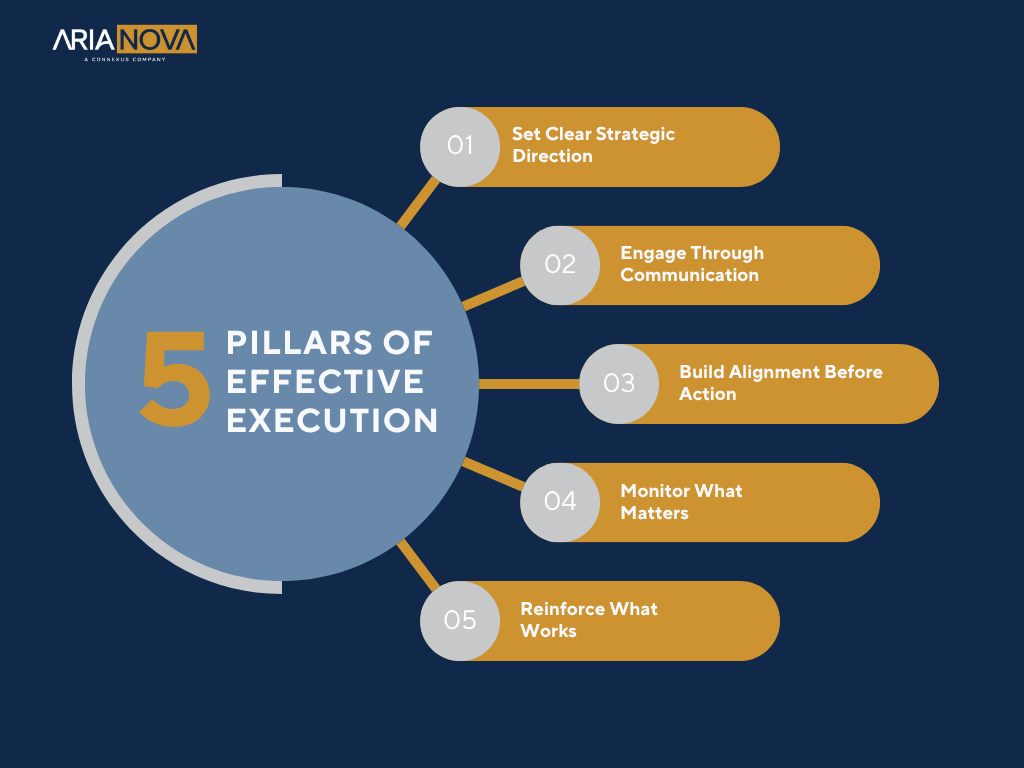In the orchestration of organizational success, strategy sets the vision. However, it is execution that transforms direction into results. The most resilient organizations don’t just plan well, they deliver with focus and discipline.
Too often, execution is treated as an afterthought. When it’s only considered after strategy is set, teams end up reacting instead of progressing. The real question is not just what your strategy says, but whether your organization is built to carry it forward with consistency and clarity.
This article explores how to sharpen your execution strategy by eliminating distractions, focusing on what drives impact, and creating the conditions for meaningful progress.
Why Execution Fails
A strategy can be solid and still collapse during execution. What gets in the way is often not a lack of ambition but distraction and fragmentation.
Common failure points include:
- Excessive planning without action
- Siloed communication and mixed messages
- Competing priorities that stretch teams too thin
- Inflexible processes that resist change
- Weak feedback loops that delay problem-solving
Distractions play a bigger role than most realize. Research shows that workers switch tasks about every three minutes, and it takes more than 23 minutes on average to return to the original task. Further studies reveal that more than 50% of workplace distractions are self-inflicted, caused by habits like Internet browsing, checking emails, or noisy (or nosy) co-workers.
Reframe Execution as a Living System
Execution is not a final step or a static plan, it is an ongoing cycle that connects planning, alignment, action, and adaptation. In leading organizations, strategy is treated as a living system; it shapes daily decisions, not just quarterly reviews.
Effective execution depends on four essential components:
- Clear goals ensure every team understands success and their role in achieving it.
- Two-way communication creates space for feedback, adjustments, and shared ownership.
- Aligned incentives keep teams motivated to prioritize work that drives strategic outcomes.
- Real-time tracking provides visibility and accountability, helping teams adjust and deliver consistently.
When these elements work together, execution becomes a source of agility and momentum.
Focus on What Moves the Needle
Not every task deserves equal attention. While calendars fill and checklists grow, much of what occupies the workday does little to advance strategic goals. Effective execution requires a disciplined focus on the work that truly drives outcomes.
To sharpen that focus, use proven prioritization frameworks that help teams separate the essential from the expendable:
- OKRs (Objectives and Key Results)
This framework helps teams define what they aim to achieve (objectives) and how they will measure progress (key results). It keeps efforts aligned with strategic priorities and ensures that success is clearly defined and trackable.
- Eisenhower Matrix
Also known as the Urgent vs. Important matrix, this tool helps categorize tasks into four quadrants: urgent and important, important but not urgent, urgent but not important, and neither. It encourages proactive work on strategic items rather than constant reaction to perceived urgency.
- Impact vs. Effort Matrix
This visual tool maps tasks based on their potential impact and the effort required to complete them. It helps teams prioritize high-impact, low-effort work and reassess tasks that require heavy resources but deliver minimal value.


To embed this mindset into everyday decision-making, ask two simple but powerful questions:
- Does this task directly support a strategic priority?
- What would happen if we stopped doing it?
By regularly challenging the purpose and value of work, teams can redirect energy toward what truly moves the organization forward.
The 5 Pillars of Effective Execution
Execution thrives not just on effort, but on structure. The most effective organizations build the conditions for execution through clarity, alignment, and reinforcement. These five pillars help ensure that strategy moves from intention to sustained results:

Set Clear Strategic Direction
Execution starts with a unified understanding of where the organization is headed. Corporate, business, and functional strategies should all point in the same direction. When each level understands how success is defined and how their work contributes, the entire system moves with greater coherence.
Engage Through Communication
A strategy has little value if it is never discussed. Bring it into regular team meetings, one-on-ones, and day-to-day conversations. Communication should flow in both directions, allowing feedback to shape execution in real time.
Build Alignment Before Action
Before teams begin to execute, goals and responsibilities must be clear. Define roles, expectations, and key metrics in advance.
Monitor What Matters
More reporting does not mean more clarity. Focus on tracking a small number of high-impact metrics that connect directly to your strategic goals. Use dashboards and regular check-ins to stay focused on outcomes rather than activity.
Reinforce What Works
Sustain progress by recognizing the behaviors that move strategy forward. Rather than celebrating tasks alone, highlight contributions that advance long-term goals. Recognition aligned with impact builds momentum and reinforces a results-driven culture.
When these pillars are consistently reinforced, execution becomes part of how your organization thinks, not just what it does. It creates a system where strategy is not only well designed but actively and confidently delivered.
Why Strategy Execution Matters
Focused execution is what transforms a strategic plan into real business outcomes. When teams know where they’re going and how to get there, the benefits ripple across the organization:
- Everyone has a clear direction.
- Decisions happen faster and with more confidence.
- Resources are used more effectively.
- Employees feel connected and motivated.
- Long-term success becomes more achievable.
Focused execution is not just a tactical advantage, it is a leadership discipline that strengthens decision-making, builds momentum, and reinforces trust across the organization. When strategy is clearly understood and consistently applied, execution becomes a force that drives sustainable growth.
Why Strategy Execution Is So Hard
Turning strategy into action is one of the toughest challenges in modern organizations. The problem often is not with the strategy itself, but with the structural friction that slows it down.
Common blockers include:
- Gaps between leadership intent and frontline execution
- Layers of complexity that delay decisions and create misalignment
- Short bursts of momentum that fade without reinforcement
- Role confusion that undermines collaboration
- Limited visibility into performance that stalls course correction


These are more than operational issues. They weaken trust, slow progress, and dilute impact. Solving them requires more than better plans. It takes alignment, clarity, and the discipline to keep execution simple and focused.
The Focused Execution Framework: 4 Steps to Sharpen Strategy and Sustain Momentum
A refined execution strategy doesn’t just happen, it is orchestrated with intention. It requires structure, alignment, and the discipline to focus on actions that drive real progress, not just activity. This four-step framework simplifies the complexity without oversimplifying the process. It helps your teams concentrate on what moves the needle and confidently let go of what doesn’t.
Step 1: Define Where You’re Headed and Why It Matters
Before execution can begin, strategy must be grounded in clarity. That clarity must resonate from the top of the organization to the frontlines. It starts with corporate strategy (your vision and direction), flows through business strategy (your competitive approach and market application), and arrives at functional strategy (how teams put the plan into action).
This is not just planning for planning’s sake. Lack of clear definition across these levels often leaves teams second-guessing. Without a shared understanding of the destination, execution becomes fragmented and ineffective.
Focus opportunity:
Audit your strategic planning process. Are corporate, business, and functional strategies aligned and mutually reinforcing, or are they disconnected?
Step 2: Align and Activate the Strategy Across the Organization
Alignment is not just leadership buy-in, it’s about making the strategy actionable at every level of the organization. This is often where execution efforts quietly fail.
A strategy that only lives in presentation decks will never come to life. Activation bridges the gap. That means translating strategic goals into priorities, timelines, and performance expectations your teams can own. It’s important to distinguish the difference between strategy alignment and strategy activation. Alignment clarifies the plan, while activation drives motion.
Focus opportunity:
Clarify who owns strategic activation across departments. Define what success looks like at each layer of the organization.
Step 3: Execute with Discipline and Focus
Execution is not about doing more, but about doing the right things with precision. Effective execution requires rhythm, clarity, and accountability across all levels.
According to Harvard Business Review, successful strategy execution depends on four building blocks:
- Information flow: Strategy should be communicated openly, frequently, and in all directions.
- Decision rights: Everyone should understand who is responsible for what decisions.
- Motivators: Incentives must align with strategic impact, not just completion of tasks.
- Structures: Workflows should support agility and enable the right people to lead.
Busywork is the enemy of focus. Refining your strategy means filtering out low-value efforts and keeping your teams focused on what truly drives results.
Focus opportunity:
Review your current initiatives. Ask whether each one directly supports this quarter’s strategic objectives. If it does not, consider stopping or postponing it.
Step 4: Assess and Adapt for Continuous Improvement
Execution is not a one-time push. It is a continuous cycle of learning and improvement. The most successful organizations review their progress often, with objectivity and data.
Conduct regular strategy reviews, real-time performance metrics such as OKRs and KPIs, and be responsive to reallocation of resources.
Adaptation is not failure, it is maturity. When teams adapt quickly based on insights, they close the gap between strategy and performance more effectively.
Focus opportunity:
Build a strategic review rhythm to assess progress and adjust for the next cycle.
This four-step model provides a disciplined yet adaptable framework. It helps teams stay aligned and focused, ensuring they maintain the goal without losing sight of the bigger picture. Refined execution means you are not just busy, you are also building momentum with purpose.
Drop the Tasks That Don’t Matter
Even great strategies stall when attention is wasted on low-value tasks. Based on recent studies, here are top time-wasters that hurt execution:
1. Unnecessary Meetings
Employees spend 21.5 hours per week in meetings; 71% are unproductive.
What to do:
- Decline meetings without a clear agenda.
- Replace status updates with async check-ins.
- Cap meetings at 25 minutes.
2. Multitasking
Multitasking cuts productivity by 40%.
What to do:
- Use time-blocking to protect focus.
- Try Pomodoro sessions for mental rhythm.
- Align deep work with your peak energy hours.
3. No Clear Priorities
Without clear priorities, teams chase urgency instead of impact.
What to do:
- Use the Eisenhower Matrix to sort tasks.
- Protect time for strategic projects.
- Run weekly “priority audits” to refocus effort.
4. Poor Planning
Most people underestimate task durations by 25 to 50%.
What to do:
- Double your time estimates until data proves otherwise.
- Build in 15-minute transition buffers.
- Under-schedule your week using the 70% rule.
5. Email Overload
The average worker checks email 77 times per day.
What to do:
- Limit email checks to three times daily.
- Turn off notifications during focus blocks.
- Use the two-minute rule to process emails efficiently.
6. Ineffective Delegation
Unclear roles lead to duplicated work and missed responsibilities.
What to do:
- Match tasks to team members’ strengths.
- Clarify ownership and expected outcomes.
- Track responsibilities using shared project boards.
7. Over-communication
Constant pings and scattered messages dilute clarity and reduce deep work.
What to do:
- Centralize updates to one platform.
- Batch communication at fixed times.
- Set daily “quiet hours” for uninterrupted work.
8. Remote Work Distractions
Household interruptions and lack of structure blur the line between work and personal time.
What to do:
- Set up a dedicated workspace.
- Establish consistent start and end routines.
- Communicate your work hours to others at home.
9. Procrastination and Overthinking
Delays caused by indecision or perfectionism increase stress and reduce execution speed.
What to do:
- Break big tasks into smaller, actionable steps.
- Set mini-deadlines to keep momentum.
- Focus on making progress, not on getting it perfect.
10. Social Media
Frequent checking breaks attention and limits the ability to do deep, focused work.
What to do:
- Log out of apps during work blocks.
- Use tools to block access during focus hours.
- Replace scrolling breaks with short resets or movement.
Refined Execution Starts with Focused Teams
In a landscape of non-stop noise, the most strategic thing you can do is protect your focus. That means creating conditions where people can move through work with clarity and avoid constant context-switching.


Refined execution strategy is not just about what you do but about creating an environment that allows the right work to actually happen. Here’s what that looks like in practice:
1. Reduce Cognitive Load
- Turn off default notifications. (Email pings, Slack alerts, calendar pop-ups.)
- Batch communication blocks instead of constant monitoring.
- Use tools like Freedom or AntiSocial to block known distractions during focus hours.
2. Structure Your Day Around Strategic Work
- Begin with 1–3 high-impact tasks tied to your strategic objectives.
- Use time-blocking to protect deep work rather than leaving it to “whenever there’s time.”
- Schedule email, Slack, or admin time after core work blocks.
3. Reinforce Single-Tasking as a Team Norm
- Encourage a “one tab open” mindset, or use separate desktops for separate workflows.
- Reward focus and progress not volume of multitasked activity.
- Track project performance based on outcomes, not just time spent.
When done right, these practices allow your strategy to move from intention to reality without burning out your team in the process.
10 Practical Ways to Regain Focus When Execution Slows
Regaining focus is key to getting execution back on track. Here are practical steps that can help individuals and teams refocus on what matters.
Set clear outcomes
When work feels uncertain, progress slows. Defining what success looks like helps teams focus. Clear outcomes give direction, reduce confusion, and keep attention on what matters most.
Break work into smaller parts
Large, complex tasks often lead to procrastination. Breaking them down into smaller steps makes them easier to start and finish. It also helps teams track progress and adjust as needed.
Protect energy and well-being
Tired people don’t execute well. Prioritizing sleep, breaks, and mental recovery supports better decisions and sustained effort. Healthy teams work smarter and last longer.
Limit distractions
Distractions pull attention away from meaningful work. Turn off notifications, reduce non-essential meetings, and create quiet time for deep focus. The fewer inputs, the better the output.
Work in focused intervals
Use time blocks, like 25 minutes of focused work followed by short breaks. This helps maintain energy and avoid burnout. It also builds a steady rhythm that supports consistent execution.
Identify the real blockers
If motivation drops, take a step back. Is the task unclear? Is the workload too high? Understanding what’s getting in the way helps leaders remove obstacles and support teams effectively.
Celebrate progress
Even small wins matter. Recognize when tasks are completed, goals are met, or momentum returns. Positive reinforcement helps maintain motivation and makes the work feel worthwhile.
Change the environment
Sometimes a new setting helps reset focus. Moving to a different space, even briefly, can bring new energy and perspective. A small shift can make a big difference in clarity.
Use helpful tools
Productivity apps like RescueTime, Forest, or Freedom can support focused work. These tools help people manage their time, reduce distractions, and stay aligned with their priorities.
Reach out for support
If focus continues to slip, encourage open conversation. People often just need clarity, feedback, or reassurance. Support is a strength, and asking for it helps everyone execute better.
Turning Strategy into Consistent Action
At ARIA NOVA, we help organizations close the gap between vision and results. Our work blends strategy and design to create execution frameworks tailored to each client’s context. Instead of offering generic models, we co-design practical systems that simplify decision-making, strengthen alignment, and sustain momentum.
We place equal weight on people and processes, ensuring that culture and accountability align with the tools and structures that support execution. This balance enables organizations to move beyond planning into purposeful, consistent action.
If your teams are ready to turn strategy into impact, ARIA NOVA can partner with you to build the clarity, focus, and resilience required for lasting success

Final Thought: Subtract to Accelerate
Execution is where strategy earns its credibility. A plan, no matter how well crafted, only proves its value when it shapes decisions and produces results. The organizations that succeed are those that treat execution as a capability to be cultivated rather than a checklist to be completed.
What distinguishes them is not perfection but consistency:
- They create systems that adapt to change
- Build trust through clear accountability, and
- Sustain momentum even when conditions shift.
By viewing execution as a living discipline, leaders position their organizations to move forward with confidence and purpose.
For more insights on refining your execution strategy and creating impactful systems, connect with ARIA NOVA on LinkedIn. Join the conversation and stay updated on how to sharpen your organizational focus for lasting success.

DESIGNED BY Social Circle
© 2024 ARIANOVA,
a Connexus company
PRIVACY POLICY
Terms of Service
documentation